Once in a while, I offer a glimpse behind the scenes of our nomadic lifestyle. Yes, I do often write about the ups and downs of life on the road, but rarely in detail. If you’ve been following along for a while – or read my memoir, Plunge – you know that I aim to present a realistic image of being perpetual travelers.
Let’s pick up where I left off in January: departing the Las Lomas Campground in La Paz after running the place and being stationary there for one month. It was a nice break that let us catch our breaths from the challenges of the road, but it brought (unexpected) consequences, namely an array of road blocks, the start of rainy season, and a dog attack.
Road blocks are “a thing” in Bolivia, meaning they are quite common and often related to the political situation involving ex-president Evo Morales. I just finished reading a great memoir by fellow overlander and virtual friend Mary Hollendoner, called Monkeys on the Road, in which she describes being stuck in what almost became a Bolivian revolution in 2019! Interestingly, this happened while she was camped at Las Lomas Campground. Their plans in this country were affected as well.
Ironically, this latest set of road blocks started on January 22nd, which was Plurinational State Foundation Day, a newish holiday initiated in 2009 to celebrate Bolivia’s multi-ethnic identity. That’s when the indigenous people started their political protests. Our next destination was the constitutional capital and World Heritage Site of Sucre, but access was impossible.

These road blocks popped up while we were still camped in La Paz
Mark and I gave it a few more days in La Paz and then left to a split in the road further south, near Oruro, where we camped for another two nights at Sora Sora. Based on the roadblock situation, we could drive to Sucre from there, or skip the town and head to Uyuni, where its salt flats are the highlight of Bolivia.
But first, we needed gasoline for Thirsty Bella. The Bolivian government makes it difficult for foreigners to fill up their tanks, as fuel stations need special systems and paperwork to make that happen. Plus, the price for non-Bolivians is more than twice what it is for locals. We believed using a jerry can circumvents some of these issues, but it sure is a hassle to get gasoline this way. Yet, that would be our approach.
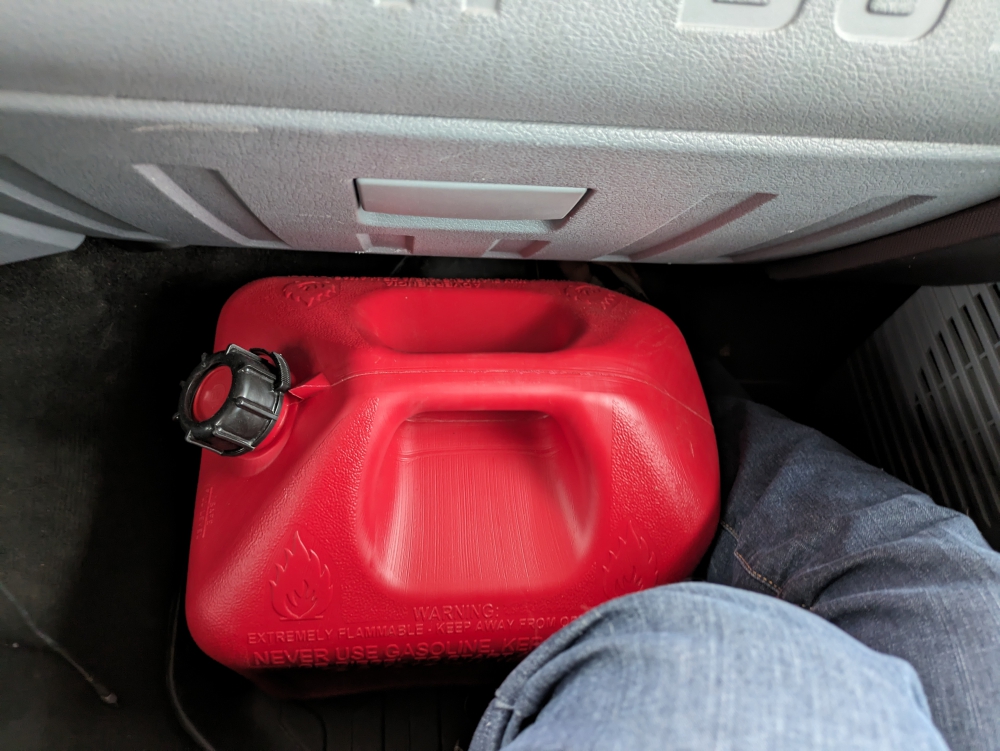
My travel companion in Bolivia
On our last day in La Paz, we paid the painful amount of $35 for a red, plastic container that would travel at my feet throughout the country. Empty and unused, this was not an issue. For good or for bad, it remained empty for a while as every gas station we stopped at in the vicinity of La Paz was out of gasoline. The idea was to stop at each station, buy one jerrycan worth of fuel, and empty it in our tank.
Before that even happened, we made a quick stop in the town of Sica Sica, where Mark double-checked Maya’s leash and harness, as this is where disaster struck not too long ago for overlanding friends of ours. A festival with firecrackers took place, their dog ran off, and was killed by a car. Sure enough, we heard fireworks a few minutes into our walk. A colorful wedding was in full swing at the church we had hoped to visit. We left without tragedies.
We had come from Peru on the fuel that was left and we needed to top up. A couple of hours south of La Paz, after a handful of unsuccessful attempts to buy gasoline, we found a station that had it. What follows appeared to be standard procedure for the rest of our time trying to buy fuel in Bolivia.
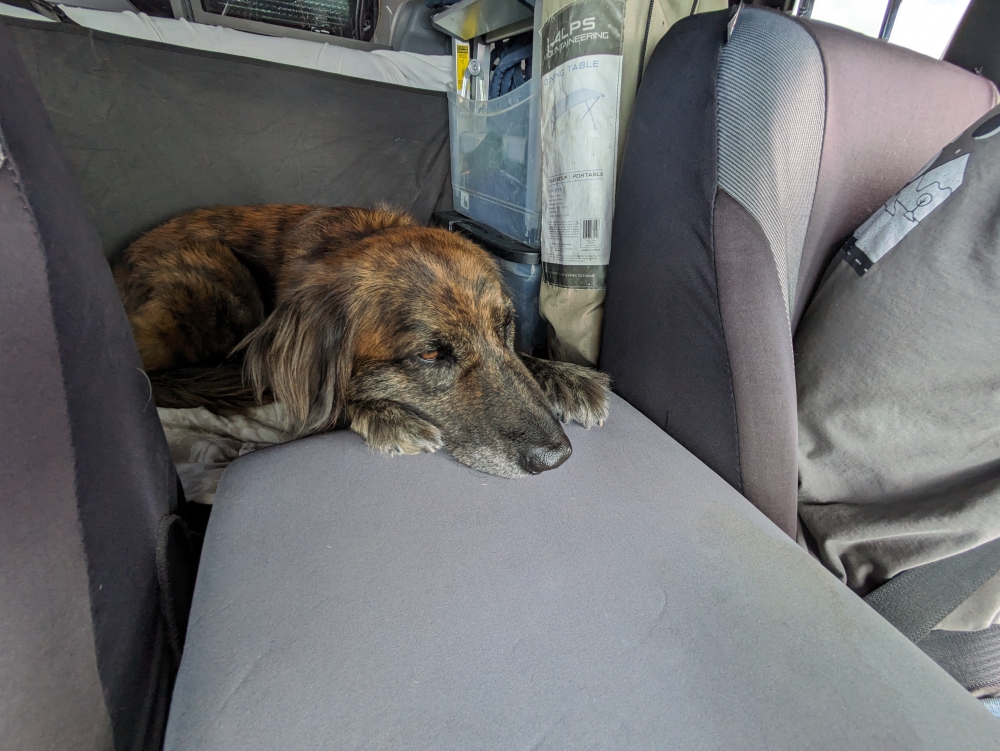
Maya, our patient travel companion
Mark parks away from the establishment and I walk to the pumps and attendant with my red jerry can. I greet the person and ask him/her to fill the jug with 19 liters of gasoline. Raised eyebrows. Then, I am told one of four options: I have to cue behind the long line of cars with my can, they don’t fill jerrycans today and I have to return another day, they don’t have the system to sell fuel to foreigners, or I have to pay the full price of almost 9 Bolivianos per liter (US$1.30). Basically, they don’t really want to help me.
If the last situation occurs, there is hope. The attendant is willing to sell and negotiate. I just have to be patient. Some overland travelers don’t want to deal with these negotiations and pay the full price, ideally getting fuel straight into their vehicles. Or they think it is fair that they are overcharged. This rule originates from big eighteen-wheeler semi-trucks filling up with thousands of liters in Bolivia, which is surrounded by more expensive countries. Surely, restricting the amount of fuel for visitors would be an easier solution?
Being on a budget, feeling that foreigners are taken advantage of (we “pump” a decent amount of money back into the local economies), and knowing that employees usually agree to a better price and pocket the difference, we are willing to take our chances. So, I wait, with my can, and chat with the attendant in between the filling of cars and away from potential listening ears, until we agree on a per liter price, somewhere between the local and international amount.
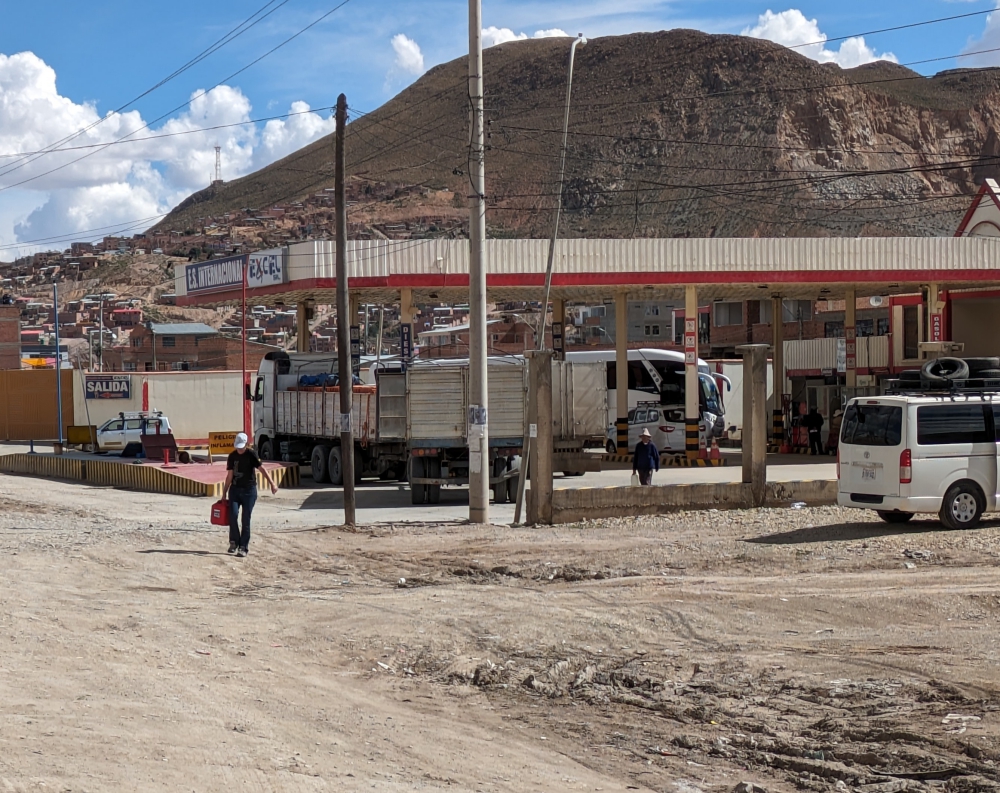
Walking to the gas station to secure a 5-gallon jerrycan of fuel
The employee fills my jerrycan, I haul it back to the truck, and Mark empties it into our tank, spilling some on his hands. Then, we have to go through this again at the next fuel station that is not closed and has gasoline. But first, hands are washed and fumes are breathed in, since the smelly can lives with us in the cab.
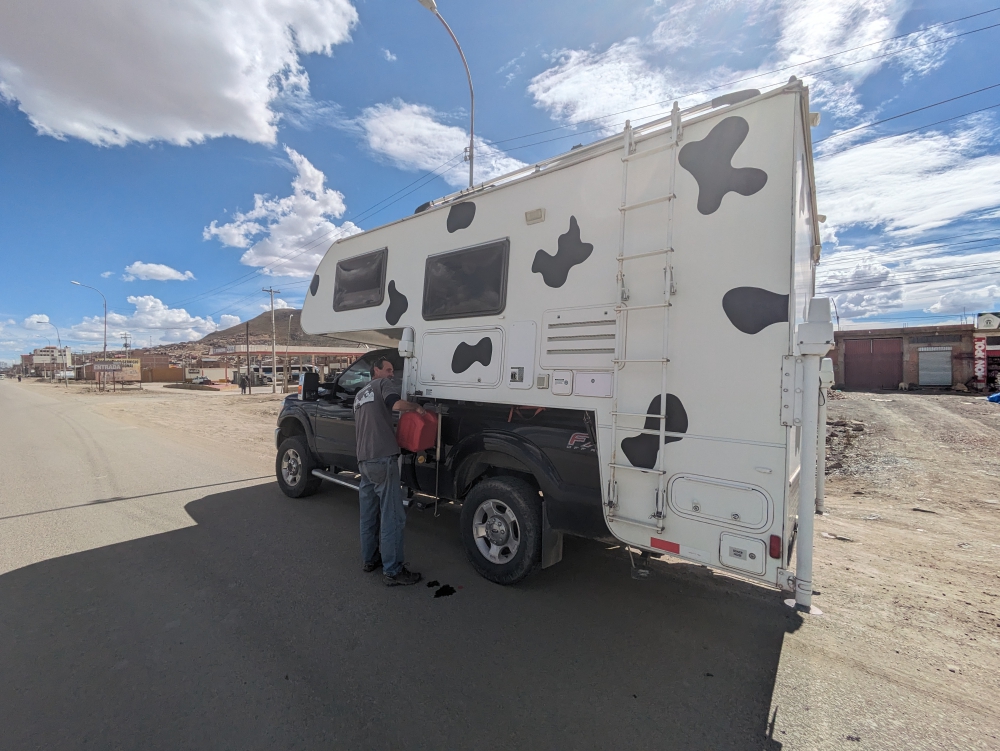
Mark empties the can into the truck, but can’t tilt it all the way, so one liter remains in the can each time.
We stop at each gas station that first day on the road – and repeat the process. Eventually, we manage to fill our fuel tank and the jerrycan, which joins my feet on the passenger side, spilling on the floor mat and making us dizzy from the fumes that escape.
And that’s how we reach our camp spot by the Sora Sora ruins, where we refresh the online road blockage map multiple times a day, work at our computers, and decide to skip Sucre. We do pass a removed road block on the way south.
Uyuni, often called a “shit hole,” probably because of its dusty and sandy roads that turn into mud and nasty street-wide puddles after rains, is a quick stop for many backpackers and overlanders. They drive (in the dry season) – or do a tour – on the Salar of Uyuni, the largest salt flat in the world and a must-do in South America, and leave.
It’s what we plan to do: a quick sightseeing stop and then exploring a bit more of Southern Bolivia before heading into Argentina. But, during our walk in Uyuni, inquiring at travel agencies about a day tour with Maya the following day, our girl gets attacked (for the third time in this country!) by a loose dog. This time, there is blood!
The number of dogs – often owned but let loose on the streets – in Bolivia has been insane. They are everywhere and often roaming in packs, which means you definitely have to be careful. We know of several people being bitten as well. It truly is a problem and an impediment for us, especially now.
We spot the owners of this dog and confront them with Maya’s open wound, stating we have to go to the vet. They take responsibility and accompany us to their animal clinic, worried and fronting the initial bill. Maya receives anesthesia, stitches, and antibiotics. Our plans change again. We postpone our tour of the salt flat to allow our dog extra rest and a vet check-up in two days. And, we are not able to obtain a health certificate required to enter the next country, as Maya now has an open wound which prevents a clean bill of health. We are stuck in delightful Uyuni. Good thing we received ninety days upon entry in Bolivia!
That first night, we camp in town, next to a military base. As we get ready for bed at 10pm, there’s a knock on the door. If we could move forward a bit? A neighbor is adamant about parking on the narrow curb between us and the buildings. You got me… We oblige with the necessary inconveniences and don’t sleep well due to heavy traffic nearby.
Luckily, the following day we find a decent camping spot by the Train Cemetery, a tourist attraction in town and the first stop on tours.
The daily rain storms keep the dust down, there is plenty of space to walk Maya, and it is quiet at night. But the number of flies is insane! Once the tour groups leave, we have the place to ourselves.
The old train wrecks are a delight to photograph and the small scrap metal art exhibit is nice as well.
During the week that follows, we work, we visit the amazing Salar, we try to find fresh vegetables among the wilted produce at the market, we forego meat as there is no decent grocery store in Uyuni and the orange chicken worries us, we research options for potential destinations, Maya’s wound heals well, and her stitches are removed.
At this point, we are fed up with Uyuni (and Bolivia) and all we want to do is leave. We have our minds set on the western border with Chile now and the only thing we need (apart from more fuel and food) is a health certificate for Maya. Except, our vet is out of forms and can’t get new ones due to the road blocks. Now we really are stuck and it’s getting old…
Mark contacts all the heads of SENASAG (agriculture) in the big cities and we communicate, research, and inquire about obtaining this permit (without having to drive hundreds of extra miles) for two full days. Eventually, a plan emerges. There is another vet in Uyuni we can go to for a local, government-approved health certificate. We do that on a Saturday, after waiting in line at the bank by 7:15am and paying the SENASAG bill inside at 8:30am. All goes well, the vet calls our “influential contact” in Potosi, and we learn what’s next.
The local vet will scan the documents and forward them to our man in Potosi, who will create the international health certificate and send it back to us by bus, Monday morning. There is no bus on Monday morning, so the document arrives in town by 5pm. We swing by the vet’s office after waiting all day in the center of Uyuni, receive the important certificate, and ask him to give Maya her next rabies shot as it is cheap here and he had promised on Saturday to do this today.
Of course, he realizes they don’t have those shots at the clinic anymore, so he can’t administer one. We easily could have gotten it at another vet, while hanging around town all day. At 5:30pm, it’s too late for that, because we really, really, really want to leave Uyuni and get settled before dark.
This is probably the latest (unforced) departure time we ever had to reach the next destination in our truck camper, but the urge to leave Uyuni is huge and we find a quiet, remote camping spot just before dark, about an hour west of town.
We did it! We escaped the grips of Uyuni and are eager to visit one more place before leaving Bolivia…
Next up: Two Otherworldly Highlights in Bolivia – Salar de Uyuni & Valle de las Rocas
Curious about a previous ten-year chapter in our nomadic lives, which includes eight years aboard a 35-foot sailboat in the tropics with dogs, check out my compelling, inspiring, and refreshingly honest travel memoir:













































































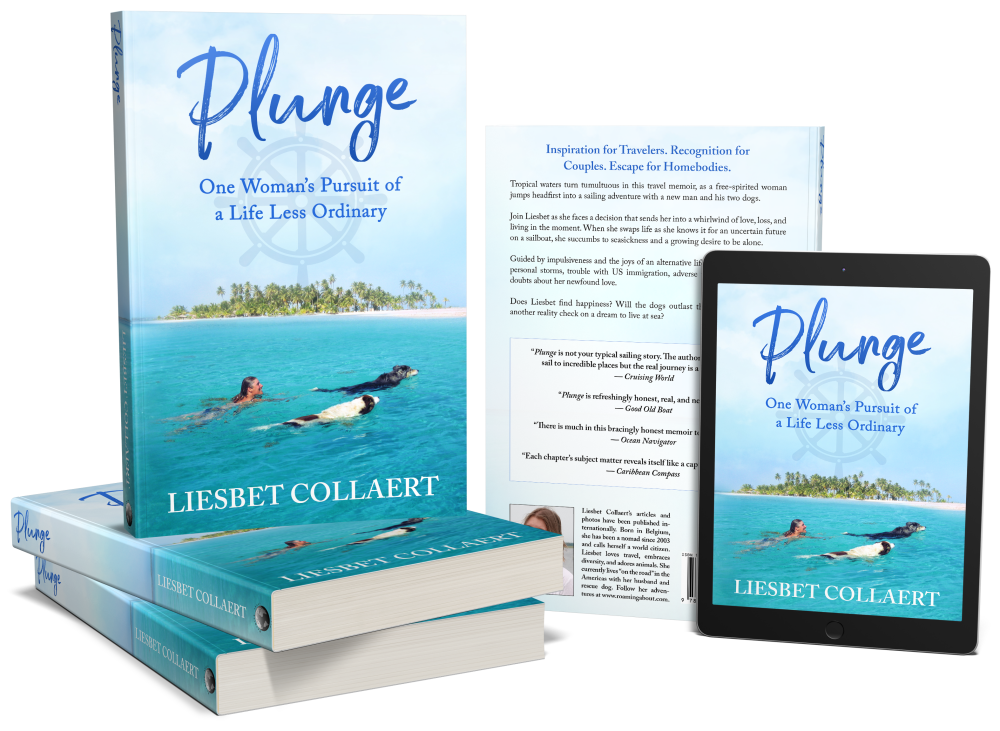




February 17, 2024 at 13:59
Hoo boy. I’m glad Maya is good. She’s such a sweet dog.
February 18, 2024 at 08:37
Hi Jacqui,
Yes, it’s all about Maya! 🙂 Our dogs have been the driving factor for pretty much every decision we made/make – from the right type of sailboat and camper, to the places we visit, anchor, and camp, to their needs and comforts. We are very happy with the job of this vet and how quickly Maya’s wound healed. It allowed us to leave Bolivia without too much of a delay!
February 17, 2024 at 14:19
Poor Maya, that looked like a nasty wound. I’m glad it’s all healed up and she’s got a clean bill of health. I remember how traumatic it was when Kai was attacked by another dog in Albania. We nearly lost him. First from the attack, then second from an unlicenced vet not cleaning the wound and administering an antiparasitic (not an antibiotic) that is fatal to some breeds of dog. Thankfully, not Cavapoos! Fortunately, we found a vet to treat him properly, although by then the wound was badly infected.
You were very lucky the owner took responsibility and paid for the treatment.
It’s awful when you’re stuck somewhere you don’t like because of circumstance. We were stuck in Bulgaria for two months while we got Iskra, the stray we picked up, well enough to have her rabies jab, then for it to be valid for travel, which takes 21 days.
The overlanding road is always rocky, but I wish you some smooth sections going forward!
February 18, 2024 at 08:45
Hi Jackie,
Yeah, that episode with Kai must have been super scary! I can’t believe that a vet would 1) not know how to treat a wound, 2) get away with being unlicensed, and 3) not care enough about animals to behave like this. It’s disgusting! I don’t even want to think how many lives he ruined instead of saved. 🙁
As for the owners paying for Maya’s treatment, that was only the first – but most substantial – visit to the vet, not the follow-ups and removal of the stitches. Luckily, pet health care is cheap in S. America.
I remember the story of Iskra. You two are amazing people! The good thing in our lifestyles is that we have time. Occasionally, we might not spend that time the way we want to, but luckily, there are no legal consequences (yet) in each of these delayed situations. Mark just hated the feeling of “being stuck” – usually, we have time commitments and decisions in our own hands.
February 17, 2024 at 16:08
You three are true rock stars. I would have run away screaming from the start. That’s why I love following your adventures from the warmth and comfort of my living room couch (yes, I’m a wimp….I know)!
February 18, 2024 at 08:48
Hi Donna,
I have a feeling that there might come a time, when we are fed up with circumstances like these. It happened on our sailboat, Irie, after eight years. When the troubles and disappointments and exhaustion become too much, it will be time for something else. After an extended break from the nomadic lifestyle. Luckily, we are not there yet. So, please, keep enjoying our (mis)adventures from that comfy couch! 🙂
February 17, 2024 at 16:55
I’m with Donna… your travels are fascinating, as long as I can read them while enjoying the creature comforts of home. Bolivia seems like a great country to leave. 🙂
February 18, 2024 at 08:50
Haha, Janis, your comment made me smile. Yes, it was time to leave Bolivia. Unfortunately, we didn’t see and experience a lot in that country, but, because of its central location and borders with many other countries, we might be back. Maybe when the fuel situation improves (if it ever does) or when we feel recharged to take on a few extra battles. 🙂
February 17, 2024 at 17:02
Oh, my goodness, Liesbet. Just getting gas would give me fits, but most of all I ached for Maya’s “ow-wee” and the painful vet process that followed.
As you said on my post, you guys have a companionable marriage because you “make compromises and aim for a balance.” Still, quite a challenge! 😀
February 18, 2024 at 08:52
Hi Marian,
I have always said that before a couple gets married, they should live/travel in a small space for a year and see how they get along and work out their differences. Situations like these either make or break a relationship. Although, those situations can get old for both parties involved after a while! For that reason, we are happy to have finally made it to an “easier” country, namely Chile. 🙂
February 17, 2024 at 17:25
Hope you finally got to the fantastic salt flats after the miserable experience with Maya, the vets and the paperwork. We enjoyed wandering around Sucre – too bad you couldn’t get there. The train cemetery brought back some fun memories – thanks for those.
February 18, 2024 at 08:56
Hi Annie,
Yes, we made it to the Salar and loved it (until another one of my massive migraines emerged)! As a matter of fact, we splurged on a private tour for the full, exclusive experience and to give Maya extra space and comfort. Stay tuned for photos! 🙂
If we ever return to Bolivia, Sucre will be one of our first destinations. But, I also wonder if this town stands out because it is the prettiest one in Bolivia or because it’s a highlight in South America. We visited many cute towns in Colombia, so we wonder how it compares to those.
I’m glad you enjoyed the Train Cemetery photos.
February 17, 2024 at 18:23
Liesbet, I wouldn’t lmake it through one day in your life. Those packs of dogs would be enough to send me packing. You are two very strong/crazy people. Thanks for sharing your ride.
February 18, 2024 at 09:00
Haha, Suzanne! Yes, I think we are a little bit crazy to set out on these adventures. Yet, little episodes like these happen to everyone overlanding (and sailing) abroad. But, I do feel like it’s often one after the other with us and don’t quite understand how that’s possible, compared to the relative ease of other travelers. Maybe because we do this fulltime and longterm? More risks, chances, and challenges day in day out? Of course, adding a dog to the mix, being on a budget, and needing to work all add complications and challenges to our travels.
February 17, 2024 at 18:24
These stories demonstrate why you’re braver than me. It seems two things are consistent in many of your travel experiences: (1) Loud fireworks for any excuse to shoot them off. (2) Loose and aggressive dogs. One of the guys in my writing group is in Guatemala right now. He says the same thing about dogs there.
February 18, 2024 at 09:04
Hi Pete,
Yes, those two points seem to be red threads throughout our travels. People without dogs probably don’t notice either too much, so having Maya does add complications – and restrictions – to our travels.
I remember the stray and loose dogs in Central America when we traveled through there for a year with a different truck camper, many years ago (in 2006), and with two dogs. Yet, I feel the situation in South America is worse, so far. More dogs and dog packs and a more aggressive behavior, especially in Peru and Bolivia. We will see what Chile and Argentina bring!
February 17, 2024 at 21:29
Liesbet, I’m glad Maya is OK and you were able to leave Uyuni. If you’re heading to Chile, beware of dogs there. Safe travels!
February 18, 2024 at 09:06
Hi Natalie,
We are currently in Northern Chile and – so far – we are pleasantly surprised with the dog situation. In the town we are currently camped at (Iquique), locals walk their dogs on a leash and pick up after them. There are trash cans everywhere! Such a concept. We are actually experiencing reversed culture shock here after 1.3 years in third world countries. But, we have barely scratched the surface of this country…
February 18, 2024 at 13:50
What a horrid experience. You have FAR more endurance and patience than I’d ever have!
February 23, 2024 at 12:51
Hi Diane,
I don’t know if it’s us or if this is all part of this lifestyle in South America. After our recent nightmare in Northern Chile – more about that later – I am really starting to think that we attract bad luck, on top of our intermittent stupidity…
February 18, 2024 at 14:33
Liesbet, this is beyond adventure travel, and I’m sure that Maya would agree. I’m a jogger and cyclist so I have a very strong opinion about aggressive dogs. I’ve never encountered an aggressive pack, but I’m sure it can be very frightening, and in Maya’s case, dangerous. I’m glad that you have moved beyond that. ~James
February 23, 2024 at 12:55
Hi James,
I do feel bad about runners and cyclists being chased by loose dogs. Besides exploring with your own dog, those modes of leisure also attract them. I’ve thought about that often during our travels and I have met other overlanders who have gotten bitten, either by walking or bicycling past aggressive dogs. I know Sue and Dave of Travel Tales of Life have had their fair share of similar dog encounters. Do you carry a stick with you, or how do you fend them off?
February 18, 2024 at 15:50
Poor Maya! I’m glad she made a good recovery.
February 23, 2024 at 12:55
Thanks, Anabel. She recovered nicely and was extra spoiled along the way. Of course… 🙂
February 18, 2024 at 17:16
Poor Maya. What a pain in the ass you had to go through. Is having pepper spray allowed there to protect Maya while she is out with you?
February 23, 2024 at 12:57
Hi Susan,
I don’t think pepper spray or bear spray is legal here, but we have found that a spray bottle with water and vinegar has worked splendidly to fend off aggressive – and for a while, just curious – dogs. But, needless to say, Maya always receives a lot of attention in new towns and areas. The new kid on the block has to be checked out and approved of. Or not… 🙁
February 24, 2024 at 10:55
Here’s hoping that the road ahead bring plentiful gas, no dog attacks, and better travels.
February 24, 2024 at 14:39
Haha, let’s hope so. Thanks, Heidi. Chile has been an interesting change… 🙂
February 28, 2024 at 10:28
If I ever utter the words Uyuni and say I want to go, remind me about the place, Liesbet. I’m guessing this is the worse place on your adventure so far?
Just getting fuel and then that awful situation with Maya being bitten sounds terrible. I hope she’s much better now. The dog problem is horrible. It must put lots of tourists off. As must the orange chicken.
But I do love the old train cemetery. How cool to have found that. I’ve never seen anything like it. Did the dogs there bother you at all?
March 2, 2024 at 12:27
Hello Hugh,
Uyuni is quite famous for the spectacular salt flats (see another post), so you might want to reconsider your statement about never wanting to visit… 🙂 The town, however, isn’t anything special and a bit of a dump, but we needed to deal with Maya’s paperwork there. I wouldn’t say it was the worst place we every visited on this South American journey, but we definitely didn’t plan to – or want to – spend a week there! Not a place we would return to, either.
Maya has healed well from that terrible bite, luckily, and slowly, she is getting her confidence and trust back about meeting other dogs. I don’t think the dog issue puts tourists off, as most of them don’t travel with dogs. In popular and touristy places like Uyuni, most travelers are backpackers in their twenties – many of them!
The train cemetery was quite cool – a photographer’s dream, so you would have a good time there! Some of the trains were probably haunted! 🙂 We actually visited a similar place a couple of days ago, a train museum, minus all the graffiti. And, no, those two Husky-like dogs at the train cemetery didn’t bother us at all. As a matter of fact, Mark and I both looked at each other in disbelief and commented about how mellow and undisturbed the pair was when we passed by (giving them a wide berth) with Maya. They were cute, uninterested, and mellow.
March 6, 2024 at 07:27
Haunted trains? Wow! That’s something I’d certainly like to board and take a few pictures.
So, it sounds as if these packs of dogs do not attack human’s, just other dogs? I guess if you leave them alone and do not approach them, they will leave you alone, unless you have a dog with you. It’s good to hear that Maya is getting her confidence back.
March 11, 2024 at 14:43
Hi Hugh,
We know of and have met people (one a good friend of ours) who have gotten bitten by loose dogs in Central and South America. I’ve been bitten twice in the past (in Mexico), so it pays to be careful regardless, especially when you encounter a pack. That being said, people usually don’t have issues walking around towns and the countryside in close proximity to dogs, except when running or bicycling. So, in general, if you keep your distance all is fine. Not so when walking by with a dog. The situation and scene are so very different then. Let alone all the extra barking and aggressive behavior when walking through towns. It’s just no fun and takes away from our trip and experience.
As I’m writing this, Maya was attacked again this morning, in Northern Argentina, which towns remind us of Bolivia and Peru. To say that this is getting old is an understatement. We left that town immediately. We were so upset. Luckily, Maya is okay. In the car, we determined to carry a spray bottle with us again and to not take Maya with us into villages anymore when there are loose dogs. Needless to say, we are looking forward to more western areas in this country!
March 12, 2024 at 06:48
I’m sorry to hear that Maya has got bitten again, Liesbet. But I’m glad to hear she is okay. Carrying a spray bottle around with you sounds like a good idea.
March 12, 2024 at 10:26
Yeah, it’s so unfortunate. Most loose dogs (many are owned and have collars in Argentina) are okay, but there are always bad apples. And, because Maya is so submissive, I think she attracts those ones. I think that was the fifth or sixth time an attack happened. So many times now, that I’m losing track. We will have to leave her home more often, because of this; the risk for another wound and continued mental damage is getting too big. 🙁
March 12, 2024 at 11:28
Please give Maya a big cuddle from me.
March 15, 2024 at 15:24
Thank you, dear Hugh! xox
March 3, 2024 at 18:32
What a pain the whole gas thing is. So much energy spent fueling up your rig.
Maya is a trooper. Poor thing. I’m glad that the owner of the dog did the right thing (and the dog had an owner). The dog bite could have been a much bigger nightmare. So glad Maya is OK and she heeled up well so you could leave the country.
I’m amazed at how well you do with communicating with people. I’m am so jealous of your language skills. I don’t know how anyone would be able to do a journey like this without knowing Spanish.
You guys rock!
March 5, 2024 at 11:48
Hi Duwan,
Bolivia was a difficult country to travel for us, but I am bummed that we missed some highlights. I feel like we might return one day – especially if the gas situation would become easier – but Mark is not so sure. Today, we finally managed to exchange the last of our Bolivianos into Chilean pesos. At a big loss, but that was still better than carrying the bills around for nothing.
Maya is a trooper. But, she’s still a handful as well. We love her, of course, but man can she drive us crazy at times. People who don’t know her would never believe how stubborn, distracted, and focused on “food” she can be. 🙂
I agree with you that I don’t understand how people can travel (overland – not as backpackers who only stay in touristy places, sleep in hostels, and do tours) in South and Central America extensively without knowing the language. Still, we know enough people who manage – with hand symbols, Google translate, and English. It’s insane.
But, yes, some knowledge of Spanish is extremely useful. Especially when you can have actual conversations with the locals. It’s still hard for me when more “technical” Spanish is needed, though, like at a mechanic or a vet. And, now that we are in Chile, forget most of the Spanish, vocabulary, and pronunciations I have learned!! You are right not to want to go to Spanish school in Chile or Argentina!